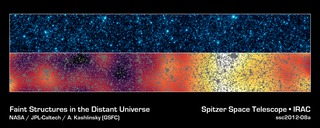
Credit: NASA/JPL-Caltech/GSFC
Observation • June 7th, 2012 • ssc2012-08a2
ssc2012-08a2
Astronomers have uncovered the patterns of light that appear to be from the first stars and galaxies that formed in the universe, hidden within a strip of sky observed by NASAs Spitzer Space Telescope.
This panel shows Spitzers typical infrared view of this patch, including foreground stars and a confusion of fainter galaxies, at a wavelength of 4.5 microns. Additional processing of this image reveals faint structures in the background that match just what we would expect for the patterns of clusters for the first galaxies formed in the universe. Even though any particular early galaxy would be too faint to see individually, this technique allows astronomers to better understand what things were like shortly after the Big Bang.
About the Object
- Name
- Cosmic Infrared Background • Extended Groth Strip
- Type
- Cosmology > Morphology > Deep Field
- Cosmology > Morphology > Cosmic Background
Color Mapping
| Band | Wavelength | Telescope |
| Infrared | 4.5 µm | Spitzer IRAC |
Astrometrics
- Position ()
- RA =14h 19m 11.8s
- Dec = 52° 48' 4.7"
- Field of View
- 1.0 x 0.1 degrees
- Orientation
- North is 49.5° left of vertical






